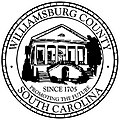2010 census
At the 2010 census, there were 34,423 people, 13,007 households, and 8,854 families living in the county. [23] The population density was 36.8 inhabitants per square mile (14.2/km2). There were 15,359 housing units at an average density of 16.4 units per square mile (6.3 units/km2). [24] The racial makeup of the county was 65.8% black or African American, 31.8% white, 0.4% Asian, 0.3% American Indian, 1.0% from other races, and 0.8% from two or more races. Those of Hispanic or Latino origin made up 2.0% of the population. [23] In terms of ancestry, and 4.6% were American. [25]
Of the 13,007 households, 33.2% had children under the age of 18 living with them, 40.0% were married couples living together, 23.0% had a female householder with no husband present, 31.9% were non-families, and 29.0% of all households were made up of individuals. The average household size was 2.53 and the average family size was 3.13. The median age was 40.2 years. [23]
The median income for a household in the county was $24,191 and the median income for a family was $33,705. Males had a median income of $37,678 versus $22,303 for females. The per capita income for the county was $13,513. About 26.5% of families and 32.9% of the population were below the poverty line, including 45.6% of those under age 18 and 27.5% of those age 65 or over. [26]
2000 census
At the 2000 census, [27] there were 37,217 people, 13,714 households, and 10,052 families living in the county. The population density was 40 people per square mile (15 people/km2). There were 15,552 housing units at an average density of 17 units per square mile (6.6 units/km2). The racial makeup of the county was 66.26% Black or African American, 32.74% White, 0.16% Native American, 0.20% Asian, 0.16% from other races, and 0.48% from two or more races. 0.73% of the population were Hispanic or Latino of any race.
There were 13,714 households, out of which 34.50% had children under the age of 18 living with them, 46.30% were married couples living together, 22.40% had a female householder with no husband present, and 26.70% were non-families. 24.90% of all households were made up of individuals, and 10.40% had someone living alone who was 65 years of age or older. The average household size was 2.69 and the average family size was 3.22.
In the county, the population was spread out, with 28.60% under the age of 18, 9.00% from 18 to 24, 25.70% from 25 to 44, 23.60% from 45 to 64, and 13.00% who were 65 years of age or older. The median age was 36 years. For every 100 females there were 87.90 males. For every 100 females age 18 and over, there were 81.50 males.
The median income for a household in the county was $24,214, and the median income for a family was $30,379. Males had a median income of $26,680 versus $18,202 for females. The per capita income for the county was $12,794. About 23.70% of families and 27.90% of the population were below the poverty line, including 36.10% of those under age 18 and 25.90% of those age 65 or over.






